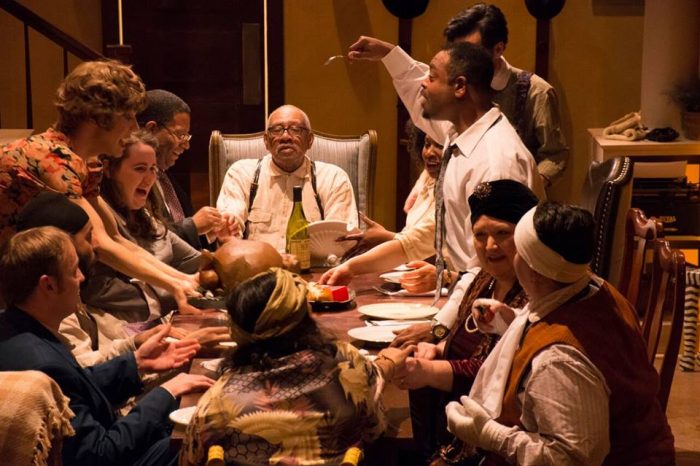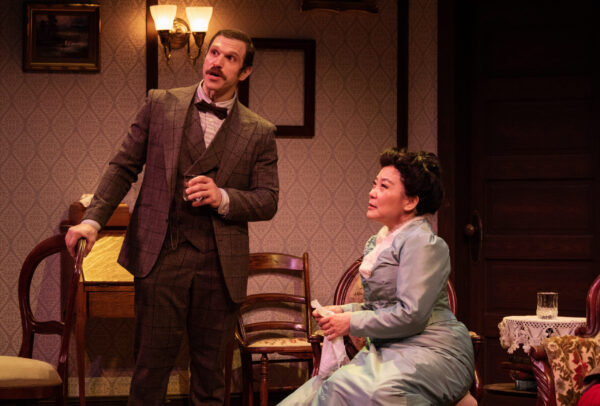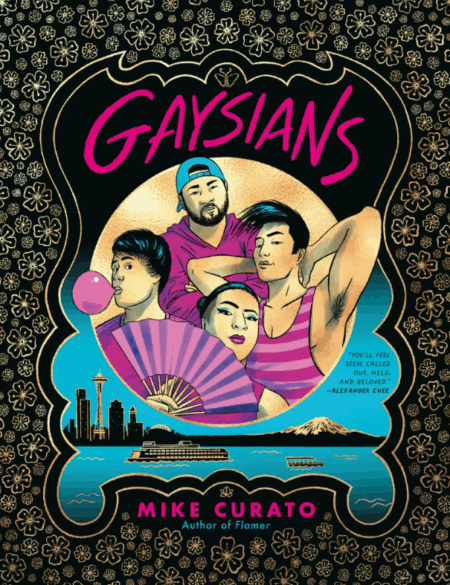
The cast of Sound Theatre Company’s YOU CAN’T TAKE IT WITH YOU onstage at Center Theatre/Seattle Center through March 10, 2018
Review: YOU CAN’T TAKE IT WITH YOU by Moss Hart and George S. Kaufman. Produced by Sound Theatre Company. Directed by Teresa Thuman. Set Design by Robin Macartney. Costume Design by Margaret Toomey. Lighting Design by Ahren Buhman. Sound Design by D.R. Amromin. With Teotha Dennard, Shermona Mitchell, Bo Mellinger, Aaron Jin, Gurvinder Pal Singh, Laurie Lynch, Alysha Curry, Geb Brown, Ayo Tushinde, Neve Kamila Mazique-Bianco, Bob Williams, Corey Spruill, Laura Steele, Chris Shea, Teresa Thuman, Andrew Weiss, Casey DeCaire, Kat Henwood. Now through March 11, 2018 at Center Theater/Seattle Center.
Sometimes old plays don’t age very well.
What was fresh and daring and bold in 1917 or 1936 or 1952 can seem tired, belabored and trite to modern eyes and contemporary tastes.
That said, there are also works that manage to seem eternally fresh and sharp witted like the classic American play, YOU CAN’T TAKE IT WITH YOU, the delightful 1936 screwball comedy about a daffy middle class New York family who get involved in a star crossed romance between the family’s daughter and the son of upper class Wall Street tycoons. It’s the Pulitzer Prize winning farce by Moss Hart and George S. Kaufman that was a huge hit in its original Broadway run and has since been performed thousands of times by professional and amateur groups worldwide for the past 80 years. (And, one that was also adapted into a very successful Oscar winning 1938 film by Frank Capra and starring James Stewart, Lionel Barrymore and Jean Arthur, as well as more than one television adaptation.)
You Can’t Take It With You is a beloved old war horse that gets frequent productions for two main reasons: 1) Amateur groups, especially schools, love it because it has a huge cast (a whopping 19 roles) so there’s a role for everyone who auditions and, 2) it’s a legitimately funny and charming script with a biting wit and plenty of topical barbs against the Establishment/Government/Fat Cats and frankly, who doesn’t enjoy a funny jab against the IRS or Wall Street? It’s also a classic screwball comedy with lots of funny physical gags and plenty of action. It’s not a dull, talky comedy. The characters DO stuff in this play.
I’m guessing Seattle’s Sound Theatre Company decided to stage this classic work for all those reasons. Sound isn’t a fully professional theater company with a staff and cast being paid union wages so they can “afford” to do a show with such an enormous cast since they’re not paying anyone very much money. Nowadays, fully professional, Equity level theaters would either just not do a show with a cast this big or if they did, the rest of their season would consist mostly of solo shows. (Want proof? ACT is doing two big cast shows this year, the 10 character The Wolves later this spring and the whopping 14 character Oslo in the fall. The 3 shows in between are two solo shows and a three hander. It’s the economics of professional non-profit theater, folks.)
Sound also had another purpose in mind with this production. The theme of their 2018 season is “The Human Family: Toward A Radical Inclusion” and the company has made it an important mission to cast their shows inclusively to give all artists regardless of race and gender a place at the table, so to speak. You Can’t Take It With You has traditionally been cast with mostly white actors; there are two roles, both servants, originally played by African-American actors in the original 1936 production. But, the most recent Broadway production starred James Earl Jones in the lead role as the family patriarch Martin Vanderhof with white actors mostly playing his family.
Sound has gone a step further with African-American actors cast in six of the leading roles, (including Grandpa Martin and both of the romantic leads) as well as actors that are South Asian, East Asian, handicapped, and non-binary. There is also gender blind casting with a male actor playing a traditional female role and a female actor playing a traditionally male cast one.
Their mandate towards inclusive casting is a timely one and part of their process of making their theater truly intersectional, where race, ethnicity, gender, orientation, ability, etc are all equal and co-existing.
The topic of intersectionality is a powerful discussion being waged right now and how does theater play a role in that discussion and to get specific, does THIS production of You Can’t Take It With You succeed at being intersectional?
It does.
That said, is this specific production an entertaining, well directed and acted staging of a beloved play?
No, it is not.
And, that’s a problem. Intersectionality is important; giving opportunities to all people…but, so is the basic need for a theater company to produce a show that actually fulfills the intentions of the material being presented. Is the comedy funny? Is the drama compelling and inspired? Are actors being cast for their emotional and artistic capabilities to play a role in addition to meeting any actual needs of physicality, whether it’s age or size? Do these actors actually fit the needs of the character and how they interact with the other characters in the material? Yes, you can most certainly cast against “type”…if the actors playing those roles and the director guiding and shaping those performances are up to it and have both the talent and the know how to do so.
But, that’s the chief weakness with this production of You Can’t Take It With You. Many of the performances aren’t up to the demands of the material and neither is Teresa Thuman’s direction. For a classic comedic play, this production is seldom very funny. There’s a very specific rhythm…well, to ANY kind of theater but comedic timing is key to the success of any performance, and this show seldom gets off the ground; it’s a leaden, joyless romp for the most part. Classic bits of comedy in this play never reach their potential; it’s a screwball comedy but it never gets a chance to be actually “screwy” and divine. We should love this crazy family of misfits and maybe secretly yearn to live like they do, but instead they seem like the annoying neighbors from Hell.
Want an example? There’s a classic moment in the play where we see every zany family member each doing their own crazy bit of physical business oblivious to each other and the outside world and it’s one of those big “aha” moments in the show…but, you wouldn’t know it from this production. It just falls flat with the dull staging and uninspired acting.
And, it’s a bit surprising because Teresa Thuman is an experienced stage director who’s been around long enough to know how comedy works…especially screwball comedy. If this show was directed by a 23 year old, I might understand how they might not “get” how to stage that kind of timing but….it’s not hard to pick up. Film isn’t the same as live theater but you can FEEL how the timing works by watching those classic screwball films of the 30s and early 40s. There’s a very certain rhythm there that is integral to the success of any staged comedy.
Since the direction isn’t on top of this situation, the result is you have a huge cast of actors that are mostly flailing. Some of them due to the fact you have actors of all talent levels. But, there’s also very good and well trained actors here who aren’t succeeding much better than the actors with less obvious talent or training. Still, the show does have a handful of actors who are great fits with their roles and manage to breathe life into the mostly moribund proceedings.
So, you need examples?
You have very good actors like Shermona Mitchell, miscast here as the sweetly, daffy mom figure Penny and I say miscast because: 1) Shermona Mitchell is far too young to be cast in a role as a middle aged mother of two 20something daughters; and, 2) Shermona Mitchell isn’t a “daffy” actress. She’s a very, very talented and powerful actress (and terrific at comedy) but “airy” and “vague” aren’t really in her wheelhouse. It’s like putting Meryl Streep in a role meant for Diane Keaton. Ms Mitchell is compelling here; she always is because she has talent and charisma, but she’s not soaring in this role…because it’s not a good fit for her.
Then, you have another wonderful actor like Teotha “Tee” Dennard as Grandpa and he’s certainly the correct age and has a delightfully off handed way of portraying the role. It’s charmingly conversational and fresh, like he’s making it up as he goes along. He’s a natural fit for a rule breaking but loving authority figure. (But, it should be noted there were moments on opening night however, where it felt he might not have been as assured of his lines as he should have been…)
Ayo Tushinde is a great fit as Alice, the “normal” member of the household in love with her boss’s son. She’s anxiously endearing as a young woman torn between her need to be different from her “odd” family (ie: more “normal”) and still loving them for having all those eccentricities. Like having a mother (Shermona Mitchell) who is apparently about 6 years older than she is…
As for the gender blind casting, one REALLY works well and the other…not at all. Laurie Lynch was my personal favorite actor in this production as the sweetly amiable ice man, Mr. DePinna who showed up to make his daily ice delivery but then never left. The role is played as a man, complete with overalls and patently false mustache but Ms Lynch is so endearing and portrays the part with such conviction that you don’t even notice the gender swap. It’s a small role, but so well done you keep hoping the character reappears.
That’s not the case with the casting of Seattle musical theater actor/dancer Bo Mellinger as Essie, the ballet loving sister of Alice and the daughter of Penny/granddaughter of Martin. It’s just a muscular white male actor in sleeveless dresses and the best wig in the production cavorting about onstage and playing at being a girl in a play set in 1936 without any explanation or rationale other than “diversity casting”. It just feels oddly awkward and forced and not truthful to the play and none of this is the fault of the actor. And, this isn’t to say you can’t cast a male actor in this role, but as the casting of Ms Lynch in the gender swapped role as Mr. DePinna indicates, it’s all about how it’s executed. This wasn’t executed well.
Other acting assets: Chris Shea’s very very funny “Kolenkhov”, the Russian emigre dance teacher, who gets the right tone and comedic timing down with his performance. So does, oddly enough, the director Teresa Thuman who takes on the small Act III role of the Duchess Olga Katrina and while Ms Thuman hasn’t succeeded at imparting the importance of the right timing to the majority of her actors, she herself is very funny in her brief turn.
From a design perspective, it’s not Sound’s strongest work. The set is a bit basic (though doing a large realistic period set in the confines of the oddly shaped Center House theater at Seattle Center has to be a huge challenge). And, the costumes are all over the place with some being very authentic to the time period and others…not so much. It’s tough costuming a huge cast in authentic period clothes but as I’ve said in other reviews, if smaller budgeted theater companies can’t convincingly design for period shows, then…maybe they shouldn’t do them. Especially ones that have enormous casts.
So, while Sound Theatre Company should be admired for their commitment to improving diversity in theater and the arts, it should also be just as equally important to stage meaningful and artistically compelling works that actually entertain audiences while fulfilling the needs of the script being produced. And, intersectional casting also shouldn’t feel like the company just checked off attributes on a list. The overall messiness of this production and its flat footed attempts at comedy make this a show I cannot recommend despite the noble intentions of the producing company.
















